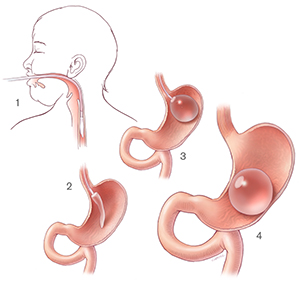Gastric Balloon
Gastric Balloon, a Nonsurgical Solution
In this nonsurgical treatment, a small balloon is inserted into the stomach to create a feeling of fullness more quickly and to help limit how much food is eaten. At Loyola, the endoscopic treatment is part of a medically supervised weight loss program that includes nutrition, exercise and support.
The gastric balloon is carried by a tiny catheter down the throat and into the stomach. Next, a bariatric specialist uses an endoscope, a flexible tube with a tiny camera, to fill the balloon with gas or fluid, such as saline.
The gastric balloon can be used for some patients who are not a good match for weight loss surgery. The amount of weight loss from this procedure is less than with surgical procedures. It may be best for patients who have a Body Mass Index (BMI) of 30 to 45, and so have fewer pounds to lose to reach a healthier weight.

Why Choose Loyola for an Gastric Balloon Procedure?
Expert weight loss doctors at Loyola are skilled in endoscopic procedures as well as medically supervised weight loss. Our team will partner with you to develop the best possible program for you and provide the resources and support you need to reach your goals.
Loyola weight loss specialists are committed to partnering with you to help you determine whether the gastric balloon is the right weight loss tool for you.
What to Expect with an Gastric Balloon
The gastric balloon is placed without surgery, so there are no incisions or loss of blood. Placement takes about 20 minutes, and most patients can go home the same day. The device is used for about six months and then removed.
Side Effects of Gastric Balloon
The procedure carries few side effects, but patients may experience nausea or vomiting after placement of the balloon.
Risks of an Gastric Balloon Procedure
Your clinical team will discuss the risks and benefits of a proposed treatment plan with you prior to any procedure. such as the gastric balloon,
Endoscopic procedures for weight loss, carry a small risk of complications. There is a risk the balloon may deflate and lead to intestinal blockage requiring surgery or endoscopy to remove the balloon.
Other complications that can occur are:
- Abdominal pain
- Allergic reactions to anesthesia
- Blood clots
- Damage to the stomach or digestive system
- Death
- Esophageal tear
- Indigestion
- Infection
- Regaining of weight
- Rupture of stitches
